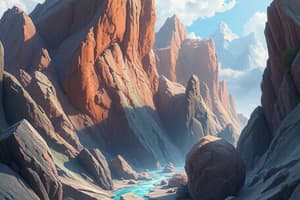Podcast
Questions and Answers
What is the primary process by which magma transforms into igneous rocks?
What is the primary process by which magma transforms into igneous rocks?
- Crystallization (correct)
- Solidification
- Disintegration
- Evaporation
What is the main factor that Norman Bowen hypothesized affects the formation of minerals in igneous rocks?
What is the main factor that Norman Bowen hypothesized affects the formation of minerals in igneous rocks?
- Pressure
- Location of magma cooling
- Composition of magma
- Temperature (correct)
What is the result of magma cooling slowly beneath Earth's surface?
What is the result of magma cooling slowly beneath Earth's surface?
- Formation of fine-grained textures
- Formation of larger crystals (correct)
- Formation of sedimentary rocks
- Immediate solidification
What did Norman Bowen observe during his study of igneous rocks?
What did Norman Bowen observe during his study of igneous rocks?
What is Bowen's Reaction Series?
What is Bowen's Reaction Series?
What did Norman Bowen use to examine the products formed during his experiments?
What did Norman Bowen use to examine the products formed during his experiments?
What was the purpose of crushing the igneous rock samples in Bowen's experiment?
What was the purpose of crushing the igneous rock samples in Bowen's experiment?
What is the primary way that minerals crystallize in Bowen's reaction series?
What is the primary way that minerals crystallize in Bowen's reaction series?
Which minerals are rich in iron and magnesium in the discontinuous series of Bowen's reaction series?
Which minerals are rich in iron and magnesium in the discontinuous series of Bowen's reaction series?
What is the sequence of minerals formed in the discontinuous series of Bowen's reaction series?
What is the sequence of minerals formed in the discontinuous series of Bowen's reaction series?
What is the primary difference between the discontinuous and continuous series of Bowen's reaction series?
What is the primary difference between the discontinuous and continuous series of Bowen's reaction series?
What is the process that explains how different igneous rocks can originate from single magma melts?
What is the process that explains how different igneous rocks can originate from single magma melts?
What happens to the crystals that have solidified within the magma during magmatic differentiation?
What happens to the crystals that have solidified within the magma during magmatic differentiation?
What is the result of magmatic differentiation?
What is the result of magmatic differentiation?
What is the purpose of the mnemonic P.M.Quiet in Bowen's reaction series?
What is the purpose of the mnemonic P.M.Quiet in Bowen's reaction series?
Study Notes
Igneous Rock Formation
- Igneous rocks are formed when magma cools and solidifies either above or below Earth's surface.
- Crystallization is the process where atoms or molecules are arranged into a defined repeating pattern known as a crystal lattice.
- Magma that cools slowly beneath Earth's surface forms larger crystals, while magma that cools quickly above Earth's surface has a finer-grained texture.
Bowen's Reaction Series
- Bowen's reaction series is a means of predicting igneous rock formation based on the temperature at which the rocks cool.
- The series shows four groups of igneous rocks: ultramafic, mafic, intermediate, and felsic.
- The mineral composition changes from ultramafic to felsic, with increasing amounts of silica, sodium, aluminum, and potassium.
- The temperature scale shows that minerals that crystallize at higher temperatures, such as olivine, are at the top, and minerals that crystallize at lower temperatures, such as quartz, are at the bottom.
Discontinuous Series
- The discontinuous series contains iron and magnesium-rich minerals.
- The series progresses from high to low temperatures, with olivine minerals rich in iron and magnesium forming first.
- The mnemonic "Olive Pits Are Bitter" helps to remember the order of minerals formed in the discontinuous series.
Continuous Series
- The continuous series involves calcium-rich plagioclase mineral at the highest temperature, which is replaced with sodium as the magma cools.
- The series is continuous, with calcium-rich plagioclase forming at the highest temperature and sodium-rich plagioclase forming at the lowest temperature.
- The mnemonic "C" in calcium coming before "S" in sodium helps to remember the order of formation.
Magmatic Differentiation
- Magmatic differentiation is the process that explains how different igneous rocks can originate from a single magma melt.
- As magma cools, crystals that have solidified within the magma tend to sink due to their increased density, altering the chemical composition of the remaining magma.
- This process results in layers of chemically divergent igneous rocks that settle out of the original magma.
- Magmatic differentiation can result in many different igneous rocks being formed from the same melt.
Studying That Suits You
Use AI to generate personalized quizzes and flashcards to suit your learning preferences.
Description
Learn about the formation of igneous rocks and Bowen's reaction series, including the process of crystallization and the effects of cooling rates on crystal texture.





